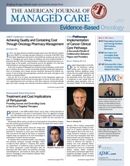Publication
Article
Evidence-Based Oncology
Medical Drug Benefit Management in the Pathway Era
Author(s):
Payers have exhausted traditional oncology benefit management options. Many of their strategies to control utilization have led to unintended consequences, such as driving poor utilization over to the medical side of the equation. As a result, payers are starting to turn to vendors for turn-key solutions to both pharmacy and medical benefits management. During a roundtable discussion,Changing the Oncology Drug Reimbursement Paradigm Through Pathway Driven Oncology Management,at the 2012 Academy of Managed Care Pharmacy Annual Meeting, William Sullivan, principal consultant, Specialty Pharmacy Solutions, LLC, provided an update on the state of oncology management.
What Is Driving Change?
Payers are under constant pressure to deliver savings to their accounts. New therapies and price of therapy are also important factors. The choice of chemotherapy is a huge cost determinant for the total cost of care. Additionally, efforts to manage oncology through traditional case management have been, for the most part, unsuccessful. “Payers just don’t have the sophistication internally to really drill down deep into managing oncology patients and the science of oncology, for example, diagnostic testing and genetics,” explained Sullivan. Oncology management extends beyond the medical and pharmacy arenas and involves cognitive, psychosocial, nutrition, hospice, and palliative aspects of care.
Another contributor to payers’ desire for a new management paradigm is excess waste. In a recent Managed Care Oncology Index report by The Zitter Group, oncologists recognized an average 18% excess cost that could be immediately eliminated and 15% of them attributed the waste to inappropriate drug utilization. Sullivan talked about some of the reasons for inappropriate utilization. Overutilization is common during late-stage disease and upon treatment failure. Prescribing patterns of oncologists are slow to change. A number of published studies have demonstrated the difficulties oncologists face in keeping their practices up-to-date with the evidence base. Additionally, fewer oncologists are practicing in the community setting—over 300 practices closed within the last 2 years, with many of those oncologists moving to hospital-based practice. This has increased the work burden on remaining community oncologists and has caused some redirection of community oncology patients to the hospital outpatient setting.
One situation that has been on everyone’s mind lately is the parity between pharmacy and medical benefits. Drugs which fall under pharmacy benefit plans, particularly oral anticancer drugs, can be associated with extremely high out-ofpocket costs for patients. On the medical side, infusible drugs may not represent optimal alternatives, but they are certainly less expensive. Concern has risen about patients being driven to certain medical alternatives simply because they are cheaper. “In fact, there is going to be a lot of legislation popping up about pharmacy and medical benefit parity,” stated Sullivan.
Who Is Delivering Innovation?
Table 1
A number of third-party vendors offer oncology management services to health plans (). Pharmacy benefit managers and specialty pharmacy both operate with a clear patient focus. Integrated single specialty providers (ISSPs), on the other hand, are third-party oncology management vendors seeking to create behavioral change around comprehensive guidelines/pathways with a focus on the oncologist, not patients.
ISSPs target both medical and pharmacy benefit management and policy to reign in total costs and increase quality and consistency of care. They are developing strategic and tactical programs to ensure appropriateness, minimize waste, and monitor and measure program compliance. This is being executed through the use of pathways and additional strategies in alignment with the pathway initiatives (Table 2). Sullivan explained, “It is a complicated recipe. Pathways are the primary ingredient, but there are about a dozen other components.”
The ISSPs in operation are citing savings of 25% in the first year for health plans that follow their complete recommended program, according to Sullivan. Health plans are not always willing to jump in with both feet right away and often prefer to start with a scaled-down version. Sullivan estimates that each individual strategy has the potential to save 0.5% to 1% annually. Generally, providers that comply with established practice standards will enjoy shared savings and other incentives. Next Frontiers: Pay for Performance, ACOs, Medical Homes The next frontier in healthcare revolves around the concept of quality. “Oncology management can actually fit into these models (ie, pay for performance, accountable care organizations [ACOs], and medical homes) pretty well,” said Sullivan. For one thing, a quality-driven model necessitates standards of quality— oncology clinical pathways represent those standards. Additionally, cancer patient populations are amenable to actuarial forecasting based on the number of cancer patients, stratified by type and stage of disease. “You can actually calculate cost factors associated with oncology pretty easily,” explained Sullivan. “You pretty much know what the course of disease will be based on progression and response to care.”
“Pathways will lower total cost of care because quality inevitably always does,” remarked Sullivan. Lower total cost of care turns into net savings and net savings turns into shared savings, which benefits everyone.
Funding Source:None.
Author Disclosure:The author reports no relationship or financial interest with any entity that would pose a conflict of interest with the subject matter of this article.
Authorship Information:Concept and design; drafting of the manuscript; and critical revision of the manuscript for important intellectual content.





